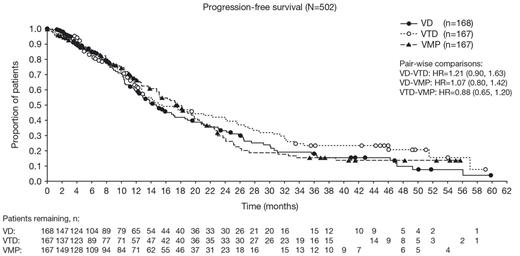Abstract
The UPFRONT trial compared the efficacy and safety of three bortezomib (V)-based induction regimens – VD (V-dexamethasone), VTD (V-thalidomide-dexamethasone), and VMP (V-melphalan-prednisone) – followed by weekly V maintenance, in previously untreated, transplant-ineligible MM pts, and was the first to prospectively evaluate VD and VTD in this population. The trial was designed to best resemble ‘real-life' treatment practice in the US community oncology setting.
Pts with symptomatic, measurable MM were randomized 1:1:1 to receive eight 21-day cycles of VD, VTD, or VMP induction (VD: V 1.3 mg/m2, d 1, 4, 8, 11; D 20 mg, d 1, 2, 4, 5, 8, 9, 11, 12 [cycles 1–4]), d 1, 2, 4, 5 [cycles 5–8]); VTD: V as before; T 100 mg/day, d 1–21; D as before); VMP: V as before; M 9 mg/m2 and P 60 mg/m2, d 1–4 every other cycle), followed by 25 weeks (five 35-day cycles) of maintenance with weekly V 1.6 mg/m2, d 1, 8, 15, 22. The primary endpoint was progression-free survival (PFS); secondary endpoints were overall survival (OS), overall response rate (ORR, partial response or better [≥PR]), complete response (CR), near-CR (nCR), and very good partial response or better (≥VGPR) rates, duration of response (DOR), time to next therapy (TTNT), safety, and quality of life (QoL). Best confirmed responses were investigator-assessed per modified IMWG criteria. Adverse events (AEs) were graded by NCI-CTCAE v3.0. Kaplan-Meier methodology was used for time-to-event analyses; hazard ratios (HR) and 95% confidence intervals (CI) are reported. QoL was assessed using the EORTC-QLQ-C30 questionnaire via a hand-held personal device. A linear mixed effect model was used to assess QoL changes over time within and between treatment arms; sensitivity analyses were conducted to test the robustness of the primary analysis. Here we report final results from the study, including updated PFS and OS, and previously unreported DOR and TTNT data for all 502 pts (VD, n=168; VTD, n=167; VMP, n=167) after a median follow-up of 42.7 months.
Baseline characteristics were generally well balanced across arms. Pts median (range) age was 73 (38–91) years; 42% of pts were aged ≥75 years. 74%/17%/9% of pts were White/Black/Other and 73% had ISS stage II/III disease. 48% of pts had baseline comorbidities and 19% had a Charlson comorbidity index of ≥2; the most common comorbidities were diabetes mellitus (21%), renal disease (15%), and chronic pulmonary disease (8%). In the VD, VTD, and VMP arms, pts received a median (range) of 8 (1–13), 6 (1–13), and 7 (1–13) cycles, respectively; 50%, 38%, and 42% of pts received V maintenance. The mean V dose intensity (number of V doses received/number of V doses planned) for VD, VTD, and VMP was 72%, 63%, and 68% during induction and 75%, 81%, and 87% during maintenance. Median PFS was 14.7 (VD), 15.4 (VTD), and 17.3 (VMP) months, respectively, with no significant difference between arms (Figure). Median OS was 49.8 (VD), 51.5 (VTD), and 53.1 (VMP) months, respectively, with no significant difference between arms (VD–VTD: HR=1.03 [95% CI: 0.73, 1.46]; VD–VMP: HR=1.12 [95% CI: 0.80, 1.58]; VTD–VMP: HR=1.09 [95% CI: 0.77, 1.54]). For VD, VTD, and VMP, best confirmed ORRs during treatment were 73%, 80%, and 70%, including 30%, 40%, and 32% CR/nCR, and 37%, 51%, and 41% ≥VGPR, respectively. Median DOR was 18.3, 22.4, and 19.8 months, and median TTNT was 19.7, 24.5, and 19.0 months, respectively. Over 13 cycles, grade ≥3 AE rates were 78%, 87%, 83%; serious AE rates were 53%, 58%, 51%; and discontinuation rates due to AEs were 29%, 38%, 34%, respectively. Across arms, the most common grade ≥3 AEs were peripheral neuropathy (23%), fatigue (10%), and diarrhea (9%). V maintenance was associated with limited additional toxicity compared with induction. For QoL, the observed data, linear mixed model estimates, and sensitivity analyses all showed a common trend for decreasing mean global health status score during V-based induction (most notably for VTD), followed by a trend to stabilizing/improving score during single-agent V maintenance.
All three V-based regimens showed substantial activity in this community-based, elderly, comorbid pt population. PFS and OS were similar between the arms. Toxicities and QoL appeared less favorable with the triplet regimens, particularly VTD, than with the doublet. These data highlight the importance of V as a backbone of therapy and the need to adapt treatment for elderly pts.
Niesvizky:Millennium: The Takeda Oncology Company: Consultancy, Honoraria, Membership on an entity’s Board of Directors or advisory committees, Research Funding, Speakers Bureau; Onyx: Consultancy, Honoraria, Research Funding, Speakers Bureau; Celgene: Consultancy, Honoraria, Membership on an entity’s Board of Directors or advisory committees, Research Funding, Speakers Bureau. Flinn:Millennium: The Takeda Oncology Company: Research Funding; Celgene: Research Funding. Rifkin:Millennium: The Takeda Oncology Company: Membership on an entity’s Board of Directors or advisory committees; Onyx: Membership on an entity’s Board of Directors or advisory committees; Celgene: Membership on an entity’s Board of Directors or advisory committees. Neuwirth:Millennium: The Takeda Oncology Company: Employment. Ba-Mancini:Millennium: The Takeda Oncology Company: Employment. Zhu:Millennium: The Takeda Oncology Company: Employment. Niculescu:Millennium: The Takeda Oncology Company: Employment.
Author notes
Asterisk with author names denotes non-ASH members.


This feature is available to Subscribers Only
Sign In or Create an Account Close Modal